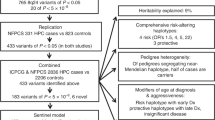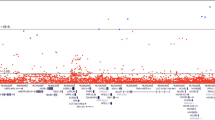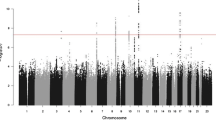Abstract
We studied a large family that presented a strong familial susceptibility to multiple early onset cancers including prostate, breast, colon, and several other uncommon cancers. Through targeted gene, linkage, and whole genome sequencing analyses, we show that the presence of a variant in the regulatory region of HNRNPA0 associated with elevated cancer incidence in this family (Hazard ratio = 7.20, p = 0.0004). Whole genome sequencing identified a second rare protein changing mutation of WIF1 that interacted with the HNRNPA0 variant resulting in extremely high risk for cancer in carriers of mutations in both genes (p = 1.98 × 10−13). Analysis of downstream targets of the mutations in these two genes showed that the HNRNPA0 mutation affected expression patterns in the PI3 kinase and ERK/MAPK signaling pathways, while the WIF1 variant influenced expression of genes that play a role in NAD biosynthesis. This is a first report of variation in HNRNPA0 influencing common cancers or of a striking interaction between rare variants coexisting in an extended pedigree and jointly affecting cancer risk.



Similar content being viewed by others
References
Abecasis GR, Cherny SS, Cookson WO, Cardon LR (2002) Merlin—rapid analysis of dense genetic maps using sparse gene flow trees. Nat Genet 30(1):97–101
DePristo MA, Banks E, Poplin R, Garimella KV, Maguire JR, Hartl C, Philippakis AA, del Angel G, Rivas MA, Hanna M et al (2011) A framework for variation discovery and genotyping using next-generation DNA sequencing data. Nat Genet 43(5):491–498
Hsieh JC, Kodjabachian L, Rebbert ML, Rattner A, Smallwood PM, Samos CH, Nusse R, Dawid IB, Nathans J (1999) A new secreted protein that binds to Wnt proteins and inhibits their activities. Nature 398(6726):431–436
Liepinsh E, Banyai L, Patthy L, Otting G (2006) NMR structure of the WIF domain of the human Wnt-inhibitory factor-1. J Mol Biol 357(3):942–950
Mazieres J, He B, You L, Xu Z, Jablons DM (2005) Wnt signaling in lung cancer. Cancer Lett 222(1):1–10
Mazieres J, He B, You L, Xu Z, Lee AY, Mikami I, Reguart N, Rosell R, McCormick F, Jablons DM (2004) Wnt inhibitory factor-1 is silenced by promoter hypermethylation in human lung cancer. Cancer Res 64(14):4717–4720
Myer VE, Steitz JA (1995) Isolation and characterization of a novel, low abundance hnRNP protein: A0. RNA 1(2):171–182
San Lucas FA, Wang G, Scheet P, Peng B (2012) Integrated annotation and analysis of genetic variants from next-generation sequencing studies with variant tools. Bioinformatics 28(3):421–422
Sobel E, Papp JC, Lange K (2002) Detection and integration of genotyping errors in statistical genetics. Am J Hum Genet 70(2):496–508
Taniguchi H, Yamamoto H, Hirata T, Miyamoto N, Oki M, Nosho K, Adachi Y, Endo T, Imai K, Shinomura Y (2005) Frequent epigenetic inactivation of Wnt inhibitory factor-1 in human gastrointestinal cancers. Oncogene 24(53):7946–7952
Wissmann C, Wild PJ, Kaiser S, Roepcke S, Stoehr R, Woenckhaus M, Kristiansen G, Hsieh JC, Hofstaedter F, Hartmann A et al (2003) WIF1, a component of the Wnt pathway, is down-regulated in prostate, breast, lung, and bladder cancer. J Pathol 201(2):204–212
Acknowledgments
This study was supported by funding from a private Donor Foundation and Grant CA016672.
Conflict of interest
The authors declare that they have no conflict of interest.
Author information
Authors and Affiliations
Corresponding authors
Additional information
Chongjuan Wei and Bo Peng have contributed equally to this work.
Electronic supplementary material
Below is the link to the electronic supplementary material.
Rights and permissions
About this article
Cite this article
Wei, C., Peng, B., Han, Y. et al. Mutations of HNRNPA0 and WIF1 predispose members of a large family to multiple cancers. Familial Cancer 14, 297–306 (2015). https://doi.org/10.1007/s10689-014-9758-8
Published:
Issue Date:
DOI: https://doi.org/10.1007/s10689-014-9758-8




